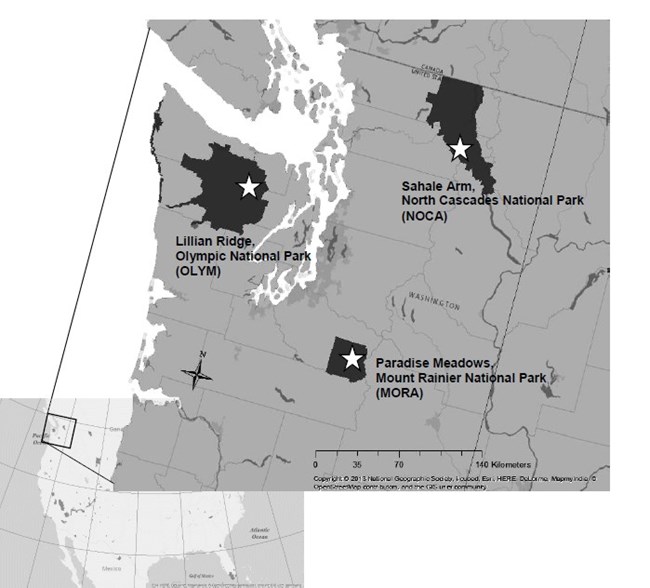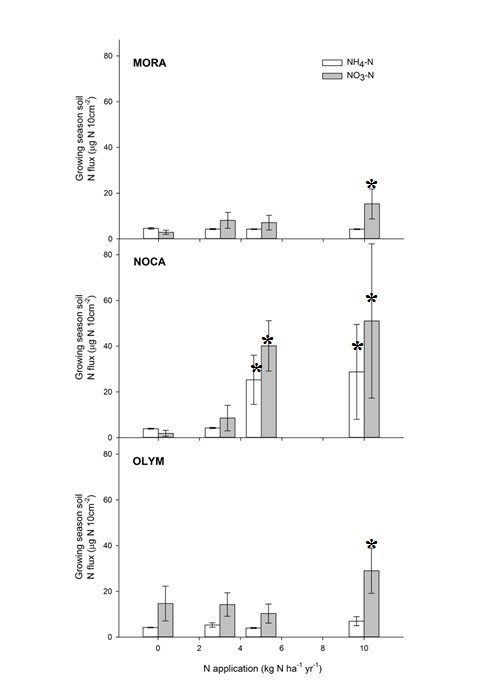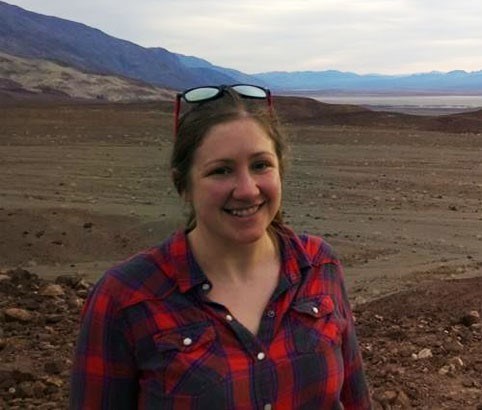Last updated: April 11, 2018
Article
Effects of Nitrogen Deposition on High Alpine Meadows in North Coast and Cascades Parks
Introduction
Alpine plant communities are limited by nitrogen (N) because they have evolved in ecosystems with naturally low levels of reactive N. They have evolved adaptations such as fixed growth rates, slow but steady nutrient uptake and short growing seasons. Plants including conifers, grasses/sedges, and forest understory plants that use N more rapidly and have faster growth rates may outcompete unique alpine and subalpine species under increased N deposition.
Increased N deposition is projected to alter plant communities, soil processes, and soil carbon (C) and N storage. Anna Simpson, a PhD Candidate at University of Washington, is studying the effects of N on alpine ecosystems. Anna is identifying the critical load of N in alpine ecosystems. A critical load is defined as the threshold of deposition below which specified harmful ecological effects do not occur.

Study Methods
Anna applied inorganic N to plant communities at study plots in three of Washington’s National Parks: North Cascades (NOCA), Olympic (OLYM), and Mount Rainier (MORA) (Figure 1). She investigated how potential future increased N-deposition could alter ecosystems using inorganic reactive (reactive, inorganic N is the form almost exclusively used by plants) N specifically: nitrate (NO3-N) and ammonium (NH4-N) at 0, 0.3, 0.5, and 1 g N/ m2/yr (grams of nitrogen per square meter per year).
Findings
After three years, all fertilized sites showed an increase in soil NO3- compared to unfertilized plots, indicating that plants and soil organisms were unable to utilize all the N. This signifies the potential for leaching. Leaching is the loss of N from the soil and into waterbodies and ground water. Leaching can cause the soil to become acidified, altering soil microbes, plant nutrition, and plant health. NOCA was more sensitive to deposition, i.e., effects occurred at the 0.5 g N/ m2/yr application rate, while MORA and OLYM responded at 1 g N/m2/yr

Over three years there was not a change in the plant community; however, there was evidence that plants and soil microbes used the applied N.
Soils are the largest sinks of N, especially meadows and grasslands where plant N storage is limited. Soil levels of reactive N were greatest in the middle of the growing season and decreased into the fall at all three parks. OLYM, however, maintained increases in microbial and reactive N into the fall which increases leaching potential with fall rains. OLYM has different soils from MORA and NOCA, with greater potential for soil microbes to process organic and reactive N. As N deposition increases, soil microbes may become more active which releases carbon dioxide (CO2) and nitrous oxide (N2O) - a greenhouse gas 300 times more potent than CO2.
Future Research Directions
Over three years the effects of increased N deposition were evidenced through increased soil NO3 - and resulting increased leaching potential. However, over time increases in deposition could stimulate soil microbes, thereby increasing inorganic and organic C and N processing which produces greenhouse gases. There is also a potential for plant community shifts as species with abilities to better utilize N increase in density and cover. This may mean an increase in grass species paired with declines in lichens, mosses, and flowering plants. Increased N deposition may also threaten endemic and rare alpine/subalpine species.
Future studies should monitor how changes in atmospheric deposition over the long term alter ecosystem processes and identify which high-elevation plant species will be most sensitive to warming climates and increased N.

Researcher
Anna received her Bachelor’s in Biology from U.C. Berkeley and did an AmeriCorps term of service at Edmonds CC’s LEAF School. She is now a PhD candidate in the soil science subgroup at the School of Environmental and Forest Sciences at the University of Washington and is a member of U.W.’s graduate Astrobiology program. Her other research focuses on changes in microbial community structure with environmental variables in snowfield soils/sediments.
More Information
Regina M. Rochefort, Ph.D.
North Cascades National Park Service Complex
Email: regina_rochefort@nps.gov
Phone: 360-854-7202
Tonnie Cummings, NPS Air Resource Specialist
Pacific West Region
Email: e-mail us
Phone: 360-816-6201
Anna Simpson, Phd Candidate
University of Washington
Email: acsimpson@gmail.com
Prepared by: Rebecca Courtney Evans
Graduate Student, Washington State University
Air Resources Assistant, GeoScientist in the Park
